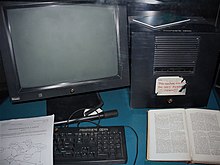CERN httpd
| CERN httpd | |
|---|---|
| Basic data
|
|
| developer | CERN / W3C |
| Current version |
3.0A ( July 15, 1996 ) |
| operating system | Unix / unix-like |
| programming language | C. |
| category | Web server |
| License | MIT Copyright Statement with CERN acknowledgment |
| http://www.w3.org/Daemon/ | |
The CERN httpd (later also W3C httpd ) was the first web server . The name httpd is an abbreviation for " HTTP - Daemon ". It was developed from 1990 to 1996 at CERN and W3C .
history
Tim Berners-Lee began in September 1990 at CERN in Geneva ( Switzerland ) in the development, simultaneously with the first web browser and -editors . At Christmas 1990 the first website http://info.cern.ch/ with the CERN httpd was put into operation on Berners-Lee's NeXT computer.
In 1991 the CERN httpd (in a package with the Line Mode Browser and a library ) was made available to the high-energy physics community, whereupon it was also used outside of CERN at universities and research institutions.
In August 1991, the package was generally published by Berners-Lee sending a message with the download address to the newsgroup alt.hypertext in which he u. a. pointed out that the web server can also be used as a web interface to e.g. B. To make content from databases generally accessible (Berners-Lee had already highlighted this feature in 1989 in the first draft of the web project as critical to success). Then the international spread of the web began. In December 1991, the first web server in the USA went online at SLAC .
In August 1993, Ari Luotonen joined the WWW project team at CERN and expanded the httpd to include features such as usability as a proxy (also with caching ) and password protection for web content (October 93).
In November 1993 support for web forms and clickable images as well /htbinas an interface for server-side scripts was added; the latter was replaced by CGI in February 1994 - an example of the pronounced dynamism of the development at that time.
After the founding of the W3C in 1994, it also took over the further development of the CERN httpd, which was then also called "W3C httpd". On July 15, 1996 the last version 3.0A was generated and development was stopped. The W3C turned instead to the development of the recently published follow-up project Jigsaw .
literature
- Tim Berners-Lee , Mark Fischetti: The Web Report. The creator of the World Wide Web on the limitless potential of the Internet . Econ, Munich 1999, ISBN 3-430-11468-3 (English: Weaving the Web: The Original Design and Ultimate Destiny of the World Wide Web .).
- James Gillies, Robert Cailliau : The Cradle of the Web. The exciting history of the WWW . Dpunkt, Heidelberg 2001, ISBN 978-3-89864-108-1 (English: How the Web Was Born: The Story of the World Wide Web (2000) .).
Web links
- Homepage of CERN httpd (English)
- info.cern.ch The first website with a short history of the web
- With 165 words into the future ( Stern article on the 20th anniversary of the WWW)
Individual evidence
- ↑ CERN ACKNOWLEDGMENT. CERN, accessed November 29, 2011 .
- ↑ Welcome to info.cern.ch - The website of the world's first-ever web server. CERN , accessed July 28, 2010 .
- ^ History of the Web. (PDF; 1.6 MB) (No longer available online.) Oxford Brookes University , 2002, archived from the original on December 26, 2011 ; accessed on July 28, 2010 (English): "The server went live on Christmas Day 1990" Info: The archive link was automatically inserted and not yet checked. Please check the original and archive link according to the instructions and then remove this notice.
- ↑ How the web began. CERN, accessed on July 26, 2010 (English): "In 1991, an early WWW system was released to the high energy physics community via the CERN program library"
- ↑ Bill Stewart e. a .: Tim Berners-Lee, Robert Cailliau, and the World Wide Web. In: Living Internet. Retrieved July 28, 2010 .
- ↑ Tim Berners-Lee: Re: Qualifiers on Hypertext links ... August 6, 1991, accessed on July 28, 2010 (Usenet message): “You can also hack it to take a hypertext address and generate a virtual hypertext document from any other data you have - database, live data etc. "
- ^ Tim Berners-Lee: Information Management: A Proposal. CERN / W3C, March 1989, accessed August 1, 2010 (English): “The system must achieve a critical usefulness early on. Existing hypertext systems have had to justify themselves solely on new data. If, however, there was an existing base of data of personnel, for example, to which new data could be linked, the value of each new piece of data would be greater. "
- ↑ Gillies, Cailliau: How the Web was born p. 262
- ↑ Change History for httpd. CERN / W3C, accessed July 28, 2010 .
- ↑ CERN httpd. W3C , accessed July 28, 2010 .
